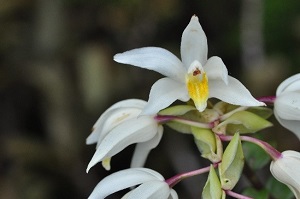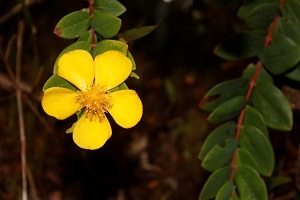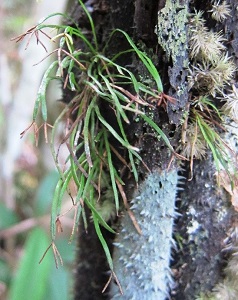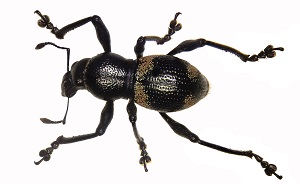 New species of orchid, flowering plant, grass fern, and snout beetle were discovered in Mt. Hamiguitan, Davao Oriental, Mindanao through a project implemented by Central Mindanao University (CMU).
New species of orchid, flowering plant, grass fern, and snout beetle were discovered in Mt. Hamiguitan, Davao Oriental, Mindanao through a project implemented by Central Mindanao University (CMU).
The project is part of the Biodiversity S&T Program of the Philippine Council for Agriculture, Aquatic and Natural Resources Research and Development of the Department of Science and Technology (DOST-PCAARRD) being implemented in collaboration with the Museum of Natural History of the University of the Philippines Los Baños (MNH-UPLB), National Museum of the Philippines (NMP), and Davao Oriental State University (DOrSU).
 A new terrestrial orchid species, called Dilochia deleoniae belonging to the Orchidaceae family was recently discovered in Mt. Hamiguitan Range in Davao Oriental. This endemic species prefers to open in partly shaded habitat, where it is found in clumps or scattered.
A new terrestrial orchid species, called Dilochia deleoniae belonging to the Orchidaceae family was recently discovered in Mt. Hamiguitan Range in Davao Oriental. This endemic species prefers to open in partly shaded habitat, where it is found in clumps or scattered.
Meanwhile, a new species of flowering plant called, Hypericum perryongii Galindon, sp. nov was discovered in a narrow summit of Mt. Hamiguitan. This species flowers from June until late July and fruits in August.
 Another flowering plant, Vaccinium hamiguitanense, of the Ericaceae family, was discovered in Mt. Hamiguitan. The said species is similar to Vaccinium gitingense but has smaller leaf blades and inflorescences with fewer flowers.
Another flowering plant, Vaccinium hamiguitanense, of the Ericaceae family, was discovered in Mt. Hamiguitan. The said species is similar to Vaccinium gitingense but has smaller leaf blades and inflorescences with fewer flowers.
A new species of grass fern, Actinostachys minuta Amoroso & Coritico was also discovered in Mt. Hamiguitan. It is an epiphyte on the trunk of the tree fern embedded between adventitious roots.
Also found in Mt. Hamiguitan is a new species of snout beetle, Metapocyrtus (Artapocyrtus) bronsi sp. nov.The new species is named after the Mandaya word “bronsi,” due to the prominent bronze scale markings on the integument.
The research team also collected a pygmy grasshopper called Arulenus validispinus, which had not been recorded for more than a century. This species is commonly known as the four-spined pygmy devil.
 Another discovery is the Gymnosiphon syceorosensis (Burmaniaceae), a type of flowering plant that obtains nutrients from mycorrhizal fungi, is considered as the second new species for the Philippines because only one population of G. syceorosensis has been discovered and no estimation of its abundance or overall distribution has been made.
Another discovery is the Gymnosiphon syceorosensis (Burmaniaceae), a type of flowering plant that obtains nutrients from mycorrhizal fungi, is considered as the second new species for the Philippines because only one population of G. syceorosensis has been discovered and no estimation of its abundance or overall distribution has been made.
 The 3-year PCAARRD’s Biodiversity S&T Program aims to update, assess, and monitor biodiversity and evaluate the physico-chemical properties of selected mountain ecosystems in Mindanao for conservation and sustainable development. Headed by Dr. Victor B. Amoroso, the assessment of biodiversity was conducted in selected mountain ecosystems such as Mt. Hamiguitan in Davao Oriental, Mt. Apo in North Cotabato, Mt. Pantaron Range in Bukidnon, and Mt. Tago Range in Bukidnon.
The 3-year PCAARRD’s Biodiversity S&T Program aims to update, assess, and monitor biodiversity and evaluate the physico-chemical properties of selected mountain ecosystems in Mindanao for conservation and sustainable development. Headed by Dr. Victor B. Amoroso, the assessment of biodiversity was conducted in selected mountain ecosystems such as Mt. Hamiguitan in Davao Oriental, Mt. Apo in North Cotabato, Mt. Pantaron Range in Bukidnon, and Mt. Tago Range in Bukidnon.
This research has explored the different ecosystems in a landscape approach, using biodiversity and forest condition assessments as basis. Among the significant accomplishments of the project is the discovery of new species and new species records for both flora and fauna in Mindanao.
Species richness and composition
Botanical inventory and assessment in Mt. Tago Range revealed a total of 490 species of plants. Of these, 60 species are bryophytes, 202 species are ferns and lycophytes, 125 species are understory flora, and 103 species are trees and shrubs. An initial 219 species of plants were documented in Mt. Hamiguitan Range Wildlife Sanctuary. Of these, 42 species are ferns and lycophytes, 139 species are understory flora, and 138 species are trees and shrubs belonging to 96 genera and 51 families.
The species of ferns and lycophytes of Mt. Tago range were documented in a checklist, along with information on their distribution and conservation status. The list is based on a comprehensive field survey conducted by the authors in 2018 and 2019 and comprises 203 species belonging to 29 families and 89 genera. Of these species, 187 are ferns and 16 are lycophytes.
Interrelated data obtained in this research will serve as a basis for policy-making bodies in formulating policies relevant to biodiversity conservation. Mentoring and capacitation of stakeholders will ensure sustainability, monitoring the remaining threatened, endemic economic/iconic species and their habitats.
